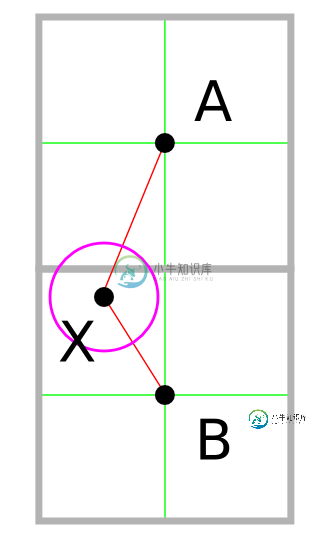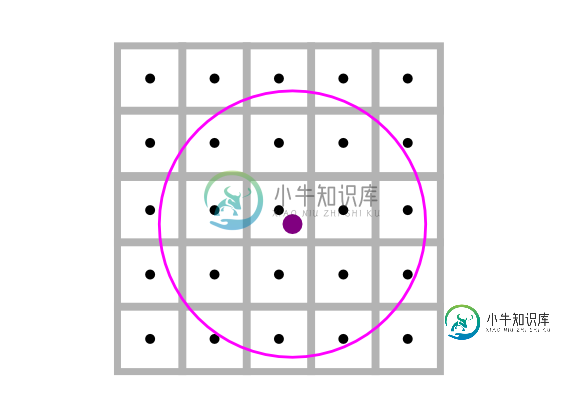计算一个圆重叠的多个正方形面积的分数
这是一个基于我的编程问题的几何问题。基本上,我有一个充满经纬度点的MySQL数据库,每个经纬度点间隔为1km,对应于每个点周围平方公里内居住的人口。然后,我想知道,这些网格中每一个的相对分数,被一个任意大小的圆圈所占,这样我就可以计算出,在一个给定的圆圈内,大致住着多少人。
以下是问题的一种形式(距离不按比例)的一个实际例子:

我想知道居住在X点半径内的人口数量。我的数据库计算出a点和B点的条目与X点足够接近,因此是相关的。本例中的A点类似于40.7458,-74.0375,而B点类似于40.7458,-74.0292。从A和B到网格边缘的每条绿线代表0.5公里,因此A和B周围的灰色圆圈分别代表1公里^2。
所以我的问题是:什么是计算网格a的分数和网格B的分数的可靠方法?
最终,我会把人口总数乘以这个分数。所以在这种情况下,周围1km^2的网格对应9561人,B周围的网格是10763人。所以,如果我知道(只是假设)X周围的半径覆盖了A的1%和B的3%,我就可以通过将A和B的人口乘以它们各自的分数,并将它们相加,对这个圆覆盖的总人口做出合理的包络后估计。
我只使用了上面的两个正方形,但根据半径的大小(可以是任意的),可能会有一大堆可能的正方形,就像这样,这使得它成为一个更普遍的问题:

谢谢你的帮助。
共有1个答案
我想,我最终想出了一个相当好的近似解决方案。以下是它在PHP中的外观:
//$p is an array of latitude, longitude, value, and distance from the centerpoint
//$cx,$cy are the lat/lon of the center point, $cr is the radius of the circle
//$pdist is the distance from each node to its edge (in this case, .5 km, since it is a 1km x 1km grid)
function sum_circle($p, $cx, $cy, $cr, $pdist) {
$total = 0; //initialize the total
$hyp = sqrt(($pdist*$pdist)+($pdist*$pdist)); //hypotenuse of distance
for($i=0; $i<count($p); $i++) { //cycle over all points
$px = $p[$i][0]; //x value of point
$py = $p[$i][1]; //y value of point
$pv = $p[$i][2]; //associated value of point (e.g. population)
$dist = $p[$i][3]; //calculated distance of point coordinate to centerpoint
//first, the easy case — items that are well outside the maximum distance
if($dist>$cr+$hyp) { //if the distance is greater than circle radius plus the hypoteneuse
$per = 0; //then use 0% of its associated value
} else if($dist+$hyp<=$cr) { //other easy case - completely inside circle (distance + hypotenuse <= radius)
$per = 1; //then use 100% of its associated value
} else { //the edge cases
$mx = ($cx-$px); $my = ($cy-$py); //calculate the angle of the difference
$theta = abs(rad2deg(atan2($my,$mx)));
$theta = abs((($theta + 89) % 90 + 90) % 90 - 89); //reduce it to a positive degree between 0 and 90
$tf = abs(1-($theta/45)); //this basically makes it so that if the angle is close to 45, it returns 0,
//if it is close to 0 or 90, it returns 1
$hyp_adjust = ($hyp*(1-$tf)+($pdist*$tf)); //now we create a mixed value that is weighted by whether the
//hypotenuse or the distance between cells should be used
$per = ($cr-$dist+$hyp_adjust)/100; //lastly, we use the above numbers to estimate what percentage of
//the square associated with the centerpoint is covered
if($per>1) $per = 1; //normalize for over 100% or under 0%
if($per<0) $per = 0;
}
$total+=$per*$pv; //add the value multiplied by the percentage to the total
}
return $total;
}
这似乎是有效的,而且非常快(尽管它确实在边缘情况下使用了一些触发)。基本逻辑是,当计算边缘情况时,两种极端的可能性是圆半径要么正好垂直于网格,要么正好与网格成45度角。因此,它大致计算出在这些极值之间的位置,然后用它大致计算出网格正方形被覆盖的百分比。它在我的测试中给出了可信的结果。
对于我使用的正方形和圆形的大小,这似乎足够了?
-
我需要计算两个函数重叠的区域。我在这个特殊的简化示例中使用正态分布,但我需要一个更通用的过程来适应其他函数。 请看下图,了解我的意思,红色区域是我想要的: 这是我到目前为止拥有的MWE: 这就是我如何应用珍雅的答案
-
总结: 我试图在r中计算大量多边形的面积。我读过几篇关于如何做的文章(例1 扩展说明: 我实际上是在计算澳大利亚维多利亚州的房产面积。多边形表示这些属性。我从Spatial Datamart下载了所有维多利亚州的VicMaps简化模型1和2。然而,考虑到形状文件的大小,我不得不将搜索范围缩小到一个地方政府区域(LGA),并计算多边形区域(仅用于测试)。形状文件为15.5MB。 这是有效的,但它不是
-
我有一个由大约4,000,000像素组成的图像。每个像素都有一个地理XY坐标(坐标位于像素的中心),每个像素对应于一个a×am平方。 假设我把一个随机点放在图像上(用随机的xy坐标),并围绕这个点画一个半径为B米的圆: 我的问题是:我怎样才能高效地计算出圆触及的是哪些正方形?
-
本文向大家介绍Python计算两个矩形重合面积代码实例,包括了Python计算两个矩形重合面积代码实例的使用技巧和注意事项,需要的朋友参考一下 这篇文章主要介绍了Python 实现两个矩形重合面积代码实例,文中通过示例代码介绍的非常详细,对大家的学习或者工作具有一定的参考学习价值,需要的朋友可以参考下 代码如下 计算两个矩形的重合面积 字符串重叠输出 以上就是本文的全部内容,希望对大家的学习有所帮
-
例如 并把这个作为背景,在上边可以放置我们设置的标题和小图片
-
问题内容: http://upload.wikimedia.org/math/f/e/5/fe56529cdaaaa9bb2f71c1ad8a1a454f.png <-区域公式 我试图从2D笛卡尔坐标系中的3个点(x,y)计算三角形的面积。我假设我的上述公式正确产生了三角形的面积(如果不是,请更正我),但是我的编译器说“运算符- 无法应用于java.awt.Point,java.awt.Point

